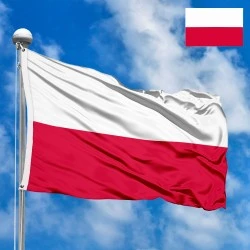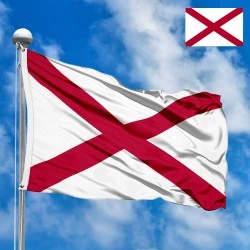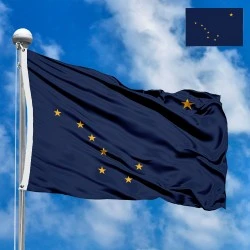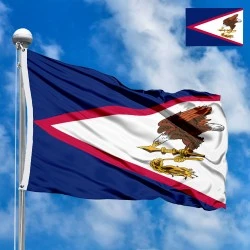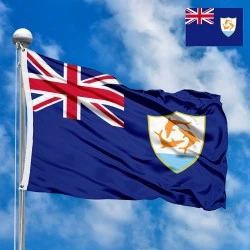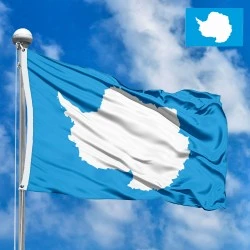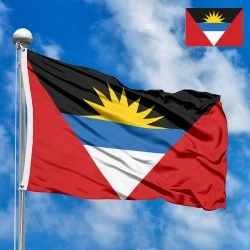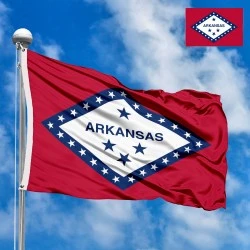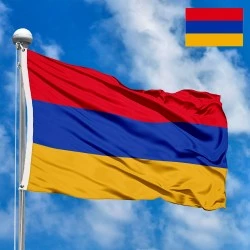- All Flags
- Flags of Countries by Continent
-
Flags of Organizations
- Flags of UN countries
- Flags of the European Union countries
- Flags of NATO countries
- Flags of the countries of the Organization of Islamic Cooperation
- Flags of the countries of the Organization of American States
- Flags of the Arab League countries
- Flags of the African Union countries
- Flags of the countries of the Union of South American Nations
- Flags of the Commonwealth of Nations
- Flags of the countries of the Secretariat of the Pacific Community
- Flags of the Nordic Council countries
- Flags of the Caribbean Community
- Flags of the countries of the Association of Southeast Asian Nations
- Flags of the East African Community
- Flags of the countries of the Organization of Turkic States
- LGBT Community Flags
- Historical Flags
- Ethnic Flags
- Flags of the USA (states)
Description
The State Flag of Poland with the Coat of Arms: The White Eagle on a Red Field – A Symbol of Millennia of History and Indomitable Spirit
The State Flag of Poland with its coat of arms is more than just a combination of colors and symbols; it is a living chronicle of a nation, embodying its dramatic history, unyielding spirit, and fervent desire for freedom. Unlike the civil flag, which consists solely of two horizontal stripes, the flag featuring the coat of arms – the White Eagle on a red shield placed in the center of the upper white stripe – holds a unique official and historical significance. It serves as a symbol of sovereignty and statehood on the international stage and in specific domestic contexts.
Dimensions, Colors, and Arrangement of Elements
The Flag of Poland with the coat of arms is a rectangular banner divided into two equal horizontal stripes: an upper white one and a lower red one. Centrally placed on the white stripe is the national coat of arms – an image of a White Eagle adorned with a golden crown, golden talons, and a golden beak, set against a red shield.
-
Dimensions and Proportions: The official proportions of the Flag of Poland with the coat of arms, mirroring the civil flag, are 5:8 (width to length). This ratio is officially enshrined in Polish law, emphasizing harmony and balance within the national symbol. This specific ratio distinguishes it from many other national flags, which often use 2:3 proportions.
-
Colors and Their Arrangement:
-
White Stripe (upper): The white color on the Polish flag is not merely a hue; it embodies purity, peace, virtue, and the pursuit of perfection. It is directly associated with the White Eagle, the primary element of the coat of arms, symbolizing its ancient origins and immaculateness. The whiteness can also evoke the snow-capped peaks of the Carpathians and the vast fields of Poland, symbolizing the purity of the land and its people. In heraldic terms, white (argent) traditionally symbolizes moral and spiritual values, as well as impeccable purity and honesty.
-
Red Stripe (lower): The red color symbolizes courage, bravery, self-sacrifice, and the blood shed by the Polish nation in its struggle for independence and freedom. It is a color of passion, vitality, and determination. The red background of the coat of arms, upon which the White Eagle is depicted, reinforces this symbolism, underscoring Poland's heroic history. In heraldry, red (gules) is traditionally associated with fire, energy, valor, and military prowess.
-
-
Coat of Arms (The White Eagle):
-
Description: The coat of arms presents a stylized image of a white eagle with a golden crown on its head, golden legs, and a golden beak, all set against a red shield. The eagle is depicted in profile, facing right, with its wings wide open, poised for flight.
-
Placement: The coat of arms is centered on the upper white stripe of the flag, which gives it particular prominence and visibility. Its size is proportional to the flag's field to ensure a harmonious aesthetic.
-
Symbolism of the Eagle: The White Eagle is the oldest and most recognizable symbol of Polish statehood, deeply rooted in the Piast dynasty. It symbolizes sovereignty, independence, majesty, nobility, and eternal vigilance. The crown on the eagle's head, which was restored after the fall of the communist regime in 1989, symbolizes the sovereignty of the Polish State, its independence from external influence, and historical continuity. The absence of the crown during the Polish People's Republic was a clear sign of Soviet domination and the loss of full sovereignty.
-
History of the Flag's Creation, Country, and Region
The history of the Polish flag with the coat of arms is inextricably linked to the formation of the Polish state and its centuries-long struggles.
-
Legendary Roots: According to an ancient legend, Prince Lech, the founder of the Polish state, during a hunt, saw a large nest of a white eagle against the backdrop of a sunset. The red sky and the white eagle became a portent for him, and on that spot, he founded the first Polish capital – Gniezno (from the word "gniazdo," meaning nest). This legend symbolically connects the flag's colors and the eagle's image with the earliest origins of Poland.
-
The Piast Dynasty and Early Coats of Arms: The White Eagle as a heraldic symbol of Poland appeared in the 13th century under the Piast dynasty, the first Polish rulers. Initially, it was a symbol of the princely family and was depicted on coins, seals, and banners. The earliest depictions of the eagle date back to the reign of Bolesław the Brave (10th-11th centuries). In the late 13th century, under Przemysł II, the eagle first appeared with a crown, symbolizing the restoration of the Kingdom of Poland and its sovereignty after a period of fragmentation.
-
Royal Banners: For centuries, the red background with the White Eagle served as a royal banner, under which Polish troops fought in numerous battles, including the famous Battle of Grunwald in 1410 against the Teutonic Knights. These banners were the predecessors of the modern state flag.
-
Formation of National Colors (18th-19th Centuries): Although white and red colors had been used in Polish heraldry since the 13th century, their official recognition as national colors came much later. In the 18th century, Polish soldiers began to wear white cockades on their headgear. In 1831, during the November Uprising against the Russian Empire, the Sejm (parliament) of the Kingdom of Poland officially adopted white and red as national colors, based on the colors of the coat of arms of Poland (white eagle on a red field) and the coat of arms of the Grand Duchy of Lithuania (white knight on a red field).
-
Rebirth of Independence and the Modern Flag (20th Century): After Poland regained independence in 1918, on August 1, 1919, the Sejm once again proclaimed the white and red flag as a national symbol. In 1927, the modern design of the White Eagle, created by Professor Zygmunt Kamiński, was approved. During the communist period (Polish People's Republic, 1945-1989), the crown was removed from the eagle's head, symbolizing the rejection of monarchical traditions and the de facto loss of full sovereignty. However, after the fall of communism in 1989, the crown was solemnly restored to the coat of arms, becoming a powerful symbol of the restoration of sovereignty, historical continuity, and democratic values. The current appearance of the flag with the coat of arms was confirmed by the Act on the Coat of Arms, Colors and Anthem of the Republic of Poland of January 31, 1980 (with subsequent amendments, including the restoration of the crown).
-
Usage of the Flag with Coat of Arms: The flag with the coat of arms is officially used by Polish diplomatic missions abroad (embassies, consulates), in airports, on civil ships (as a maritime ensign), and by certain state institutions. This underscores its role as a symbol of state representation.
Adoption and Significance for Residents
For the Polish people, the state flag with the coat of arms is one of the most sacred and revered symbols, holding deep existential significance.
-
National Identity and Pride: The flag and coat of arms are the core of Polish national identity. They unite Poles, regardless of their origin, faith, or political views, around a common history and shared values. Pride in the flag is pride in a nation that has endured countless trials and preserved its unique culture and language.
-
Symbol of Freedom and Independence: Given the centuries-long history of partitions and struggles for independence, the flag is a powerful symbol of Poland's aspiration for sovereignty and freedom. Each stripe and every detail of the eagle recall the struggles and sacrifices made by generations of Poles to preserve their statehood. The restoration of the crown on the eagle in 1989 was a moment of immense national pride and symbolized the return to true independence.
-
Memory of the Past: The flag serves as a reminder of glorious moments in Polish history – victories, uprisings, the fight for independence. It inspires the preservation of historical memory and its transmission to future generations. It also symbolizes the martyrdom and resilience of the Polish people during periods of occupation and oppression.
-
Unity and Solidarity: On national holidays, such as Constitution Day on May 3rd, Independence Day on November 11th, or Flag Day on May 2nd, Poles widely display national flags, expressing their solidarity and unity. These are days when the nation gathers together under its symbols.
-
Continuity and Traditions: The flag with the White Eagle emphasizes the continuity of Polish statehood, rooted in the Middle Ages, and the preservation of ancient traditions, despite all historical upheavals.
-
International Recognition: The flag of Poland with its coat of arms is recognized worldwide as a symbol of a sovereign European state that has always valued freedom and actively participates in international relations.
Interesting Facts
-
Two Flag Variants: Poland has two officially recognized national flags: the civil flag (only white and red stripes) and the state flag (with the coat of arms). The civil flag is used for everyday purposes, while the flag with the coat of arms is for official state purposes, especially outside the country, and on maritime vessels. This distinction sometimes causes confusion among foreigners.
-
Flag Day: Since 2004, May 2nd has been celebrated as Flag Day (Dzień Flagi Rzeczypospolitej Polskiej) in Poland. This day, introduced specifically to popularize knowledge about Polish state symbols, precedes Constitution Day on May 3rd. This demonstrates the importance Poles attach to their national symbols.
-
Red Color - "Amaranth": Although the official description of the flag simply states "red," in the historical tradition of Polish heraldry, the red color of the coat of arms was often described as "amaranth" (karmazyn) – a deep, rich shade of red that was considered a royal color. Modern standards define the exact shade of red using the Pantone system, but the historical context remains important.
-
Evolution of the Eagle: The design of the White Eagle has changed over centuries, reflecting different eras and dynasties. The current appearance, designed by Zygmunt Kamiński in 1927, is based on medieval depictions of the eagle and is considered the most canonical.
-
Absence of the Crown: The removal of the crown from the eagle's head during communist rule was one of the most noticeable changes in Polish symbolism, deeply affecting national self-awareness. Its restoration in 1989 was a symbol not only of political change but also of the restoration of national pride and historical justice.
-
Uniqueness in Europe: The Polish flag is one of the few in Europe whose colors directly derive from the colors of the national coat of arms, rather than from later revolutionary or constitutional movements, emphasizing its ancient heraldic origin.
-
Anthem and Flag: The Polish national anthem, "Mazurek Dąbrowskiego" (Dąbrowski's Mazurka), also has a deep connection to the struggle for independence and symbolizes the unyielding will of the people, just like the flag.
-
Civilian Use: Although the flag with the coat of arms is intended for official use, many Poles consider it a more complete and expressive symbol of their country and often display it on private homes or use it at various events, especially within the diaspora. While this is not formally stipulated by law for private use within Poland, it demonstrates a deep attachment to the symbol.
In the demonstration images, full-size flags are shown with proportions of 2:3, and hand-held flags with proportions of 1:2.
Donation
Download
Completely free for commercial and non-commercial use (public domain).
You can freely use them in your news magazines, websites, software, mobile applications.
We appreciate a backlink to https://flagssite.com
Raster files - Flag of Poland with coat of arms (PNG, JPG)
 Waving flag
Waving flag
- PNG format (transparent background), 72dpi, dimensions in Pixels (px), aspect ratio 3:4.
- 15х20 px
- 30х40 px
- 60х80 px
- 120x160 px
- 240x320 px
 Sizes:
Sizes:
"v15" - image size (by height); if necessary, replace with available: v15, v30, v60, v120, v240.
!!! For resizing, use the Latin (eng) keyboard layout.
<img src="https://flagssite.com/flags/v15/20245.png" alt="Flag of Poland with coat of arms">
 Round flag
Round flag
- PNG format (transparent background), 72dpi, dimensions in Pixels (px), aspect ratio 1:1.
"d15" - image size (diameter); if necessary, replace with available: d15, d30, d60, d120, d240.
!!! For resizing, use the Latin (eng) keyboard layout.
<img src="https://flagssite.com/flags/d15/20245.png" alt="Flag of Poland with coat of arms">
 Rectangular flag 2:3
Rectangular flag 2:3
- JPG format, 72dpi, dimensions in Pixels (px), aspect ratio 2:3.
"h30" - image size (by height); if necessary, replace with available: h15, h30, h60, h120, h240, h360, h480.
!!! For resizing, use the Latin (eng) keyboard layout.
<img src="https://flagssite.com/flags/h30/20245.jpg" alt="Flag of Poland with coat of arms">

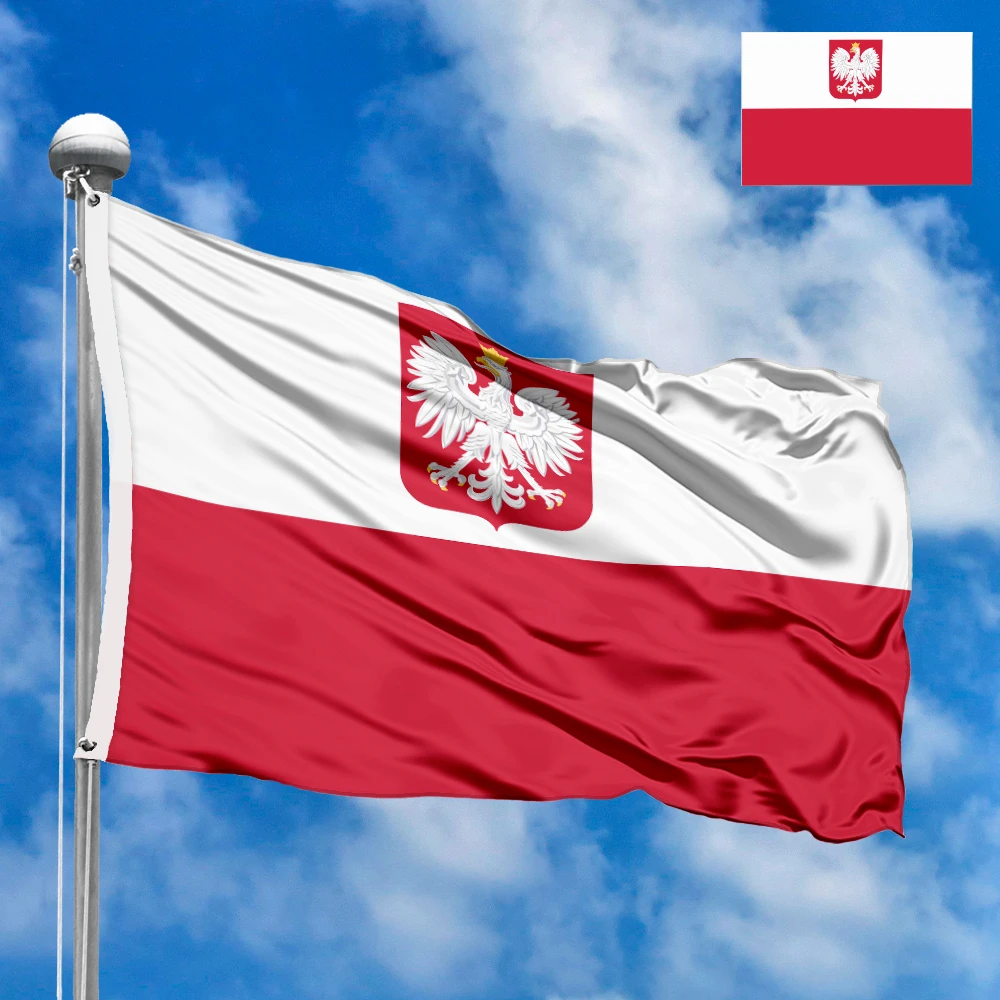
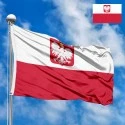
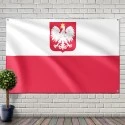
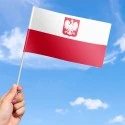

 Sizes:
Sizes:
 Sizes:
Sizes:
